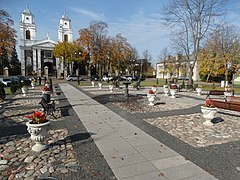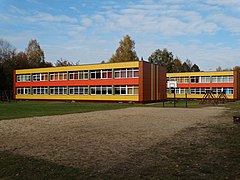Lazdijai
Lazdijai | |
|---|---|
City | |
 Vilnius Street in Lazdijai | |
| Coordinates: 54°14′N 23°31′E / 54.233°N 23.517°E | |
| Country | |
| Ethnographic region | Dzūkija |
| County | |
| Municipality | Lazdijai district municipality |
| Eldership | Lazdijai city eldership |
| Capital of | Lazdijai district municipality Lazdijai city eldership Lazdijai rural eldership |
| First mentioned | 1570 |
| Granted city rights | 1597 |
| Government | |
| • Type | District Municipality Council |
| • Body | Lazdijai District Municipality Council |
| • Mayor | Ausma Miškinienė (DSVL) |
| Area | |
• Total | 5 km2 (2 sq mi) |
| Population (2020) | |
• Total | 4,110[1] |
| Time zone | UTC+2 (EET) |
| • Summer (DST) | UTC+3 (EEST) |
Lazdijai (ⓘ) is a city (miestas) in Lithuania located about seven kilometres (4+1⁄2 mi) east of the border with Poland.[2][3]
History
[edit]It was established by Sigismund II Augustus in 1570 and granted Magdeburg Rights by Sigismund III Vasa in 1587.[4] During World War II, Lazdijai was under German occupation from 22 June 1941 until 31 July 1944.[5] On November 3, 1941, 1,535 Jews were murdered in Lazdijai, including 485 men, 511 women and 539 children[6] The perpetrators were members of the Rollkommando Hamann, local policemen and Lithuanian nationalists.
In 1990 Lithuania declared independence from the Soviet Union, and new check points between the borders Poland and Lithuania were established, and Lazdijai became the center that oversees and continues to regulate these operations.
Etymology
[edit]Lazdijai gets its name from the river Lazdija (also known as Raišupis), which runs through the city. It is, however, unclear where the name for the river comes. One possibility is that the name Raišupis is likely of Sudovian origin, having a meaning related to nuts, while the lithuanian word for hazels is lazdynai, possibly birthing the river's alternative name lazdija and the city name Lazdijai.[7]
Throughout the history the city belonged to various powers and accordingly was known under various names: Polish: Łoździeje, German: Lasdien, Russian: Лаздияй, romanized: Lazdiyay. Also, the Jewish population of the city called it Lazdei (Yiddish: לאַזדיי, לאַזדיי). See also Names of Lithuanian places in other languages.
Notable people
[edit]- Salomėja Nėris worked here as a teacher of German during 1928-1930
- Motiejus Gustaitis worked as principal of a coed gymnasium in Lazdijai.
- Adolfas Ramanauskas graduated from a Lazdijai secondary school
Birthplace
[edit]- Joseph Achron
- Marijonas Mikutavičius
- Virginijus Savukynas, Lithuanian journalist
- Avraham Tory, Jewish Lithuanian Holocaust survivor, diarist, and lawyer
- Arūnas Valinskas
Gallery
[edit]-
Independence Square in Lazdijai
-
Square near the church
-
School of Arts in Lazdijai
-
Square near the Cultural Centre of Lazdijai
-
Education Centre of Lazdijai
-
Police station in Lazdijai
-
School Vyturėlis in Lazdijai
References
[edit]- ^ "Gyventojai | Lazdijų rajono savivaldybė".
- ^ "Istorija ir Kultūros paveldas". lazdijai.lt. Retrieved 21 December 2019.
- ^ "Lazdijai". vle.lt. Retrieved 21 December 2019.
- ^ Encyclopedyja Powszechna (Universal Encyclopedia). Vol. 17 (in Polish). Warszawa: S. Orgelbrand. 1864. p. 655.
- ^ Освобождение городов
- ^ "Holocaust Atlas of Lithuania". holocaustatlas.lt. Retrieved 2017-07-15.
- ^ Vanagas, Aleksandras (2004). Lietuvos miestų vardai (2nd ed.). Vilnius: Mokslo ir enciklopedijų leidybos institutas. pp. 121–123.
External links
[edit]- The murder of the Jews of Lazdijai during World War II, at Yad Vashem website.











